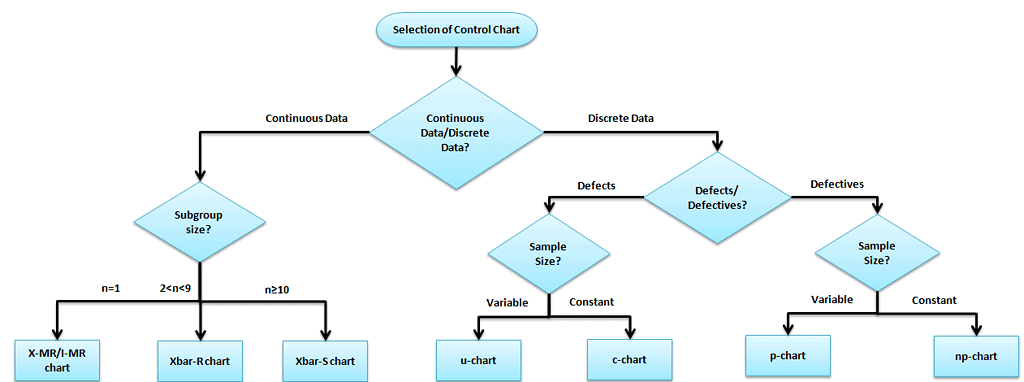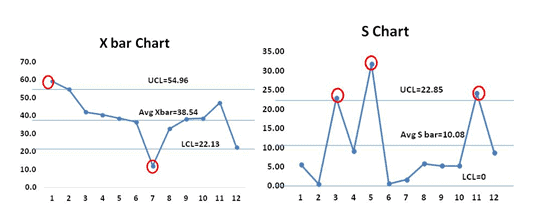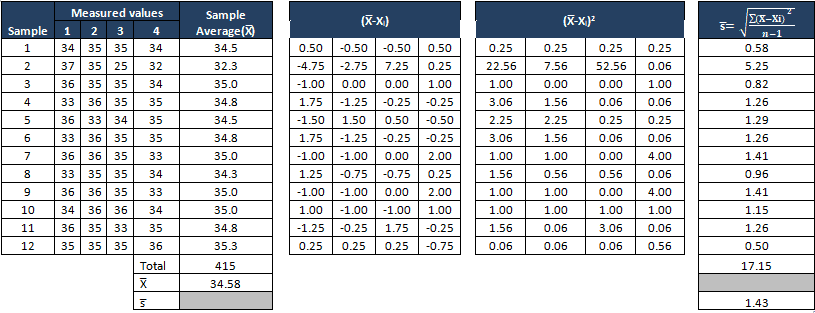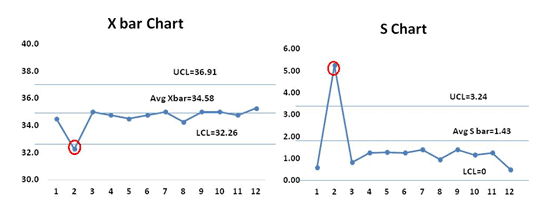An Schart is Used for Continuous Data and Whenever the Sample Size is Greater Than
What are X Bar S Control Charts?
X Bar S charts often used control chart to examine the process mean and standard deviation over the time. These charts are used when the subgroups have large sample size and S chart provides better understanding of the spread of subgroup data than range.
X bar S charts are also similar to X Bar R Control chart, the basic difference is that X bar S charts plots the subgroup standard deviation whereas R charts plots the subgroup range
Selection of appropriate control chart is very important in control charts mapping, otherwise ended up with inaccurate control limits for the data.

Manually it is very easy to compute X Bar R Control chart, where as sigma chart may be difficult due to tedious calculations and large sample size. With large sample size in the subgroup, the standard deviation is better measure of variation than the range because it considers all the data not just minimum and maximum values.
It is actually a two plots to monitor the process mean and the process range (as described by standard deviation) over time and is an example of statistical process control. These combination charts helps to understand the stability of processes and also detects the presence of special cause variation.
The cumulative sum (CUSUM) and the exponentially weighted moving average (EWMA) charts are also monitors the mean of the process, but the basic difference is unlike X bar chart they consider the previous value means at each point. Moreover these charts are considered as a reliable estimate when correct standard deviation exists.
X Bar S Control Chart Definitions
X-bar chart:The mean or average change in process over time from subgroup values. The control limits on the X-Bar brings the sample's mean and center into consideration.
S-chart: The standard deviation of the process over the time from subgroups values. This monitors the process standard deviation (as approximated by the sample moving range)
Use X Bar S Control Charts When:
- The sampling procedure is same for each sample and is carried out consistently.
- When the data is assumed to be normally distributed.
- The X bar S chart to be used when rationally collect measurements in subgroup size is more than 10.
- X Bar R chart is to be considered if the subgroup size is between two and 10 observations (for I-MR chart the subgroup size is one only).
- When the collected data is in continuous (ie Length, Weight) etc. and captures in time order
How to Interpret the X Bar S Control Charts
- To correctly interpret X bar S chart, always examine the S chart first.
- The X bar chart control limits are derived from the S bar (average standard deviation) values, if the values are out of control in S chart that means the X bar chart control limits are not accurate.
- If the points are out of control in S chart, then stop the process. Identify the special cause and address the issue. Remove those subgroups from the calculations.
- Once the S chart is in control, then review X bar chart and interpret the points against the control limits.
- All the points to be interpret against the control limits but not specification limits.
- If any point out of control in X bar chat. Identify the special cause and address the issue.

Steps to follow for X bar S chart
Objective of the chart and subgroup size
- Determine the objective of the chart and choose the important variables
- Choose the appropriate subgroup size and the sampling frequency
- Shewhart suggested collecting 20 to 25 sets of samples with a subgroup size of 10 and above
Note: To demonstrate an example, we just took subgroup size 4 in the below example, but it is always recommended to take 10 and above for X bar S chart.
Example:A packing organization monitoring the performance of a packing machine, each container should weigh 35 lb, during Measure phase, project team performed the process capability study and identified that the process is not capable(less than one sigma). In Analyze phase collected 12 sets of container weights with a subgroup size of 4.

Compute X bar and S values
- Measure the average of each subgroup i.e X bar, then compute grand average of all X bar value, this will be center line for X bar chart
- Compute the standard deviation of each subgroup, then measure grand averages of all standard values ie S bar and this will be the center line for S chart

Determine the Control Limits
The first set of subgroups are to determine the process mean and standard deviation, these values are to be consider for creation of control limits for both standard deviation and mean of each subgroup

The process to be in control in the early phase of the production. Special causes to be identified if any of the points are out of control during initial phase and also the subgroup has to be removed for calculation.
Sometimes in the initial phase it would be also good to have few points out of control on the x-bar portion. Otherwise, if all the values are within the control limits may be because of slop in the measurement system, team won't focus on it. Identify appropriate Measurement System Evaluation (MSE).

- Where
- X is the individual value (data)
- n is the sample size
- X bar is the average of reading in a sample
- S is the standard deviation
- S bar is the average of all the standard deviation.
- UCL is Upper control limit
- LCL is Lower control limit
The below control chart constants are approximate values to measure the control limits for X bar S chart and other control charts based on subgroup size

- Refer common factors for various control charts
Example cont: In the above example n=4

Interpret X bar and S chart
- Plot both X bar and S chart and identify the assignable causes
Example Cont: Use the above values and plot the X bar and Sigma chart

From the both X bar and S charts it is clearly evident that most of the values are out of control, hence the process is not stable
Monitor the process after improvement
Once the process stabilizes and control limits are in place, monitor the process performance over the time.
Example cont: Control Phase- Once the process is improved and matured, team identified the X bar S chart is one the control method in Control plan to monitor the process performance over the time period
Following are the measurement values in Control phase of the project

Compute X bar and Sigma

Find the control limits


From the both X bar and S charts it is clearly evident that the process is almost stable. During initial setup at 2nd data set both S chart and X bar chart value are out of control, team has to perform the root cause analysis for the special cause and also the process is smoothing out from the data set number 4. If that continued, the chart would need new control limits from that point.
- Since S chart is in statistical control, calculate the process standard deviation


- After the process stabilized, still if any point going out of control limits, it indicates an assignable cause exists in the process that needs to be addressed. This is an ongoing process to monitor the process performance.
Important notes on X Bar S Control Charts
- A process is "in control" that indicates means of the process is stable and it can be predictable
- A process is in stable that does not mean it's a zero defect process.
- Remember to NEVER put specifications on any kind of control chart.
- The points on the chart are comprised of averages, not individuals. Specification limits are based on individuals, not averages.
- The operator might have the tendency to not react to a point out control when the point is within the specification limits.
- X bar S chart helps to avoid unnecessary adjustments in the process
X Bar S Control Chart Videos
Source: https://sixsigmastudyguide.com/x-bar-s-chart/
Post a Comment for "An Schart is Used for Continuous Data and Whenever the Sample Size is Greater Than"